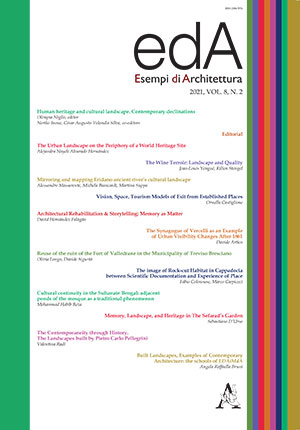Estratto da
ESEMPI DI ARCHITETTURA
International Journal of Architecture and Engineering
THE CONTEMPORANEITY THROUGH HISTORY: THE LANDSCAPES BUILT BY PIETRO CARLO PELLEGRINI
ESEMPI DI ARCHITETTURA
International Journal of Architecture and Engineering
THE CONTEMPORANEITY THROUGH HISTORY: THE LANDSCAPES BUILT BY PIETRO CARLO PELLEGRINI

Observing, interpreting, and imagining are the three main actions that the architect carries out in the project's time. Chrónos, immersed in a quantum sinusoid in which creative, historical, economic, social events and the development of design thought, ordered in a linear chronology, are traced back to a single present. Extensions, in which new works are admitted, additions and rewriting of built landscapes that restore a precarious homeostatic balance of the eco-system of architectural species, with nature on which they lay and with the man who will inhabit it.This shows that even when the most recent past seems to be destroyed by resounding events, the interpretation of persistences, archetypes and the translation of the seven intelligible perpetuities in the vitruvian essay generate new bodies capable of updating the identity of places, improving the quality of life and admitting new functionalities. Showing themselves as new meanings in the evolutionary exaptation of signifiers.This is what happens in the work of Pietro Carlo Pellegrini in Lucca, where ethos and pathos meet through the interpretative diversity of simple geometries and the refined use of materials: in the venustas of a modernity of handcraft.Eternity is expressed through regular forms that use the golden proportion in profiles and plants, tracing symmetry and eurythmy in the scanning of spaces. The modularity is revealed in the arrangement of individual parts with respect to the entire building structure and in the use of the small elements that materially make up the work. Plaster and brick are the prevailing materials, the latter modeled as a translation of ancient tectonics and rural languages.In interventions on pre-existing materials, the loan words take on structural roles: the firmitas is transferred to the new elements, while the rooms accommodate variations of utilitas. Everything happens in a circular way. The details define the hypseity of the project, the study of parapets, eaves, fixtures, plaster and color, seeking a linguistic reduction as a positive civil expression, which links theory and practice, generating new forms of monumentality.Keywords: Perpetuity, Form, Time.
| pagine: | 245-253 |
| DOI: | 10.4399/978882553987512 |
| data pubblicazione: | Dicembre 2020 |
| editore: | Aracne |








